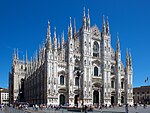Basilica vetus
313 establishments4th-century establishments in ItalyBasilica churches in MilanItalian church stubs

Santa Maria Maggiore, called the basilica vetus (old basilica) or basilica minor (minor basilica), was a church in Milan, established in 313, which served as co-cathedral alongside Santa Tecla until it was torn down after 1386 to make room for the modern cathedral. It served as the winter cathedral, while Santa Tecla was that of the summer.
Excerpt from the Wikipedia article Basilica vetus (License: CC BY-SA 3.0, Authors, Images).Basilica vetus
1_33051, Milan Municipio 1
Geographical coordinates (GPS) Address Phone number Website Nearby Places Show on map
Geographical coordinates (GPS)
| Latitude | Longitude |
|---|---|
| N 45.46425053 ° | E 9.19198808 ° |
Address
Duomo di Milano
1_33051
20122 Milan, Municipio 1
Lombardy, Italy
Open on Google Maps









